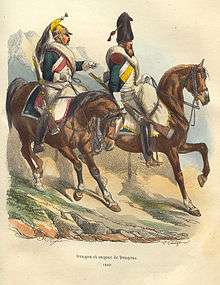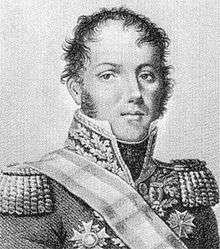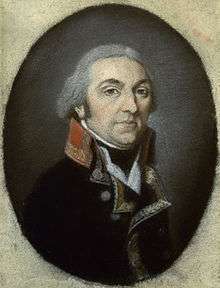Reserve Cavalry Corps (Grande Armée)
The Reserve Cavalry Corps or Cavalry Reserve of the Grande Armée was a French military unit that existed during the Napoleonic Wars. In 1805, Emperor Napoleon I appointed Marshal Joachim Murat to command all the cavalry divisions that were not directly attached to the army corps. During the Ulm campaign, Murat led his horsemen in successfully hunting down many Austrian units that escaped the capitulation of Ulm, before fighting at Austerlitz in December 1805. Under Murat, the Cavalry Reserve played a prominent role in the destruction of the Prussian armies after the Battle of Jena-Auerstedt in 1806. Five dragoon divisions of the corps were employed in the Peninsular War starting in 1808 and placed under the overall command of Marshal Jean-Baptiste Bessières. The Cavalry Reserve was reassembled in 1809 to fight Austria with Bessières still in command. In 1812, the Reserve Cavalry Corps was split up into the I, II, III, and IV Cavalry Corps for the French invasion of Russia.
| Reserve Cavalry Corps | |
|---|---|
| Active | 1805–1812 |
| Country | |
| Branch | Army |
| Type | Cavalry corps |
| Size | 5-8 cavalry divisions, along with artillery elements |
| Engagements | War of the Third Coalition War of the Fourth Coalition Peninsular War War of the Fifth Coalition |
| Commanders | |
| Notable commanders | Jean-Baptiste Bessières Joachim Murat |
History
1805

At its formation, the Grande Armée comprised seven army corps, the Imperial Guard, the artillery reserve, and the Cavalry Reserve. The latter consisted of two cuirassier, one light cavalry, and five dragoon divisions, including one dismounted. The mass of 22,000 cavalrymen was supported by 24 pieces of artillery, while the remainder of the army's cavalry was distributed among the army corps in brigades or divisions.[1] Napoleon appointed Marshal Joachim Murat to command the Reserve Cavalry. Generals Étienne Marie Antoine Champion de Nansouty and Jean-Joseph Ange d'Hautpoul led the cuirassier divisions while Generals Louis Klein, Frédéric Henri Walther, Marc Antoine de Beaumont, and François Antoine Louis Bourcier headed the dragoon divisions and General Louis Baraguey d'Hilliers commanded the dismounted unit.[2] On 8 October 1805, at the Battle of Wertingen, Murat and Marshal Jean Lannes attacked an isolated Austrian division under General Franz Xaver von Auffenberg. Murat's horsemen included Klein's 3,000-strong dragoon division, Beaumont's 2,400-man dragoon division, and light cavalry brigades under Generals Antoine Lasalle and Anne-François-Charles Trelliard. With the support of some V Corps infantry, Murat's horsemen rode down the hapless Austrians, inflicting losses of 400 killed and wounded, 2,900 prisoners, six guns, and six flags. The French admitted 174 casualties.[3]
The cavalry saw much service during the rest of the Ulm campaign. At the Battle of Haslach-Jungingen on 11 October 1805, the 15th and 17th Dragoon Regiments lost their eagles. However, the action was a French victory over a greatly superior force.[4] Murat led his horsemen in a series of actions between 16 and 18 October before securing the surrender of General Franz von Werneck's Austrian corps. In these clashes, Klein's 1st, 2nd, 4th, 14th, 20th, and 26th Dragoon Regiments, the 1st Cuirassier Regiment, and other units were involved.[5] At the Battle of Schöngrabern on 16 November, Klein's troopers were engaged as were the 11th, 13th, and 22nd Dragoons from Walther's division.[6] At the Battle of Austerlitz on 2 December, Murat led approximately 7,400 cavalrymen including Nansouty's 1st Heavy Cavalry Division, Hautpoul's 2nd Heavy Cavalry Division, Walther's 2nd Dragoon Division, General François Étienne de Kellermann's light cavalry division and General Édouard Jean Baptiste Milhaud's light cavalry brigade. Beaumont's 3rd Dragoon Division was attached to the IV Corps while Bourcier's 4th Dragoon Division with 2,500 men and three guns were attached to the III Corps.[7]
1806–1807
At the beginning of the War of the Fourth Coalition, the Reserve Corps under Murat included the 1st and 2nd Cuirassier Divisions, still commanded by Nansouty and d'Hautpoul, the 1st, 2nd, 3rd, and 4th Dragoon Divisions under Klein, General Emmanuel de Grouchy, Beaumont, and General Louis Michel Antoine Sahuc respectively, and a light cavalry division led by Lasalle.[8] The pursuit that occurred after the French victory in the Battle of Jena-Auerstedt on 14 October has been described as classic.[9] On the 16th, Murat and his cavalry accepted the surrender of Erfurt where 9,000–14,000 Prussians were made prisoners.[10] At the Battle of Prenzlau on 28 October, Murat bluffed 10,000 Prussians with 64 guns into surrendering. The next day, 4,000 Prussians surrendered to Milhaud's troopers in the capitulation of Pasewalk. Also on 29 October, Lasalle's light cavalry captured a fortress manned by 5,000 men in the capitulation of Stettin.[11]
On 16 December 1806, the Reserve Corps was split into the I Cavalry Corps under Murat and the II Cavalry Corps under Marshal Jean-Baptiste Bessières. The II Corps operated with the northern wing of the French corps that advanced across the Vistula. The II Corps consisted of the divisions of d'Hautpoul, Grouchy, and Sahuc, plus a light cavalry division under General Jacques Louis François Delaistre de Tilly. The II Corps was disbanded on 12 January 1807 and the Reserve Cavalry Corps was reconstituted.[12] During the winter campaign, the 5th Dragoon Division was formed and assigned to General Nicolas Léonard Beker. It served near Warsaw under Marshal André Masséna.[13] At the Battle of Eylau on 8 February 1807, Murat led a grand charge of 80 squadrons of cavalry, altogether 10,700 horsemen. The divisions of Grouchy, d'Hautpoul, Klein, and Milhaud were all engaged. The French cavalry suffered 1,500 casualties but they badly disrupted the Russian lines at a critical point in the battle.[14] D'Hautpoul was killed in the struggle.[15]
1808–1809

After the Battle of Bailen and the subsequent French surrender on 21 July 1808, the myth of French military invincibility was shattered. Subsequently, King Joseph I withdrew the remaining French forces behind the Ebro River.[16] Determined to conquer Spain, Napoleon resolved to go there himself with a large army. He ordered three army corps to march from Germany to reinforce Joseph's badly shaken survivors.[17] Among other reinforcements, one light cavalry and five dragoon divisions were transferred to Spain under the command of General Victor de Fay de La Tour-Maubourg, Milhaud, Generals Armand Lebrun de La Houssaye, Jean Thomas Guillaume Lorge, Jacques Louis François Milet, and Jean Baptiste Marie Franceschi-Delonne. La Tour-Maubourg led the 1st Dragoon Division with 3,695 troops, Milhaud the 2nd with 2,940, Houssaye the 3rd with 2,020, Lorge the 4th with 3,101, and Milet the 5th with 2,903. Franceschi led the 2,400-man light cavalry division. Two of Milhaud's regiments were assigned to other units and Milet was soon replaced by Kellermann.[18] On 9 November 1808, Bessières was replaced by Marshal Jean-de-Dieu Soult in charge of the II Corps and ordered to lead the Cavalry Reserve.[19] However, the Cavalry Reserve was not destined to remain intact. In December, Franceschi was already assigned to Soult, Houssaye and Lorge were directed to join Soult, and Milet was still on the march to Spain. Meanwhile, La Tour-Maubourg and Milhaud were assigned to help defend Madrid.[20] Bessières remained with the cavalry near Madrid.[21] Meanwhile, the French won the Battle of Tudela on 23 November 1808. General Alexandre Digeon participated in combat with two regiments of La Tour-Maubourg's division, 1,200 strong.[22] While Lannes and the French infantry put the Spanish center and right wing to flight, Digeon's and a second brigade of French cavalry immobilized 10,000 soldiers of the Spanish left wing.[23]
When the War of the Fifth Coalition broke out in 1809, Bessières returned from Spain to lead the Cavalry Reserve. The corps included the 1st, 2nd, and 3rd Heavy Cavalry divisions, led by Nansouty, and Generals Raymond-Gaspard de Bonardi de Saint-Sulpice and Jean-Louis-Brigitte Espagne respectively. Each division consisted of four regiments of cuirassiers, while the 1st Division also had two regiments of Carabiniers-à-Cheval. There was also a light cavalry division under Lasalle.[24] On 21 May at the Battle of Aspern-Essling, Bessières led 7,000 horsemen in a series of clashes with the Austrian in open ground between the villages. During the day, Espagne was killed by an Austrian cavalryman. In the evening, Saint-Sulpice's division and one of Nansouty's brigades arrived so that the French employed 12,000 cavalry on 22 May. That same day, the Reserve Cavalry supported a powerful infantry attack in the morning, but the effort failed and Napoleon realized that he had to retreat.[25] At the Battle of Wagram on 5–6 July 1809, the 3rd Heavy Cavalry Division was headed by General Jean-Toussaint Arrighi de Casanova.[26]
In 1812, the Reserve Cavalry Corps was split up into the I, II, III, and IV Cavalry Corps for the invasion of Russia. Each corps consisted of two heavy cavalry divisions and one light cavalry division, except the IV which had one heavy and one light cavalry division. Nansouty led the I, General Louis-Pierre Montbrun the II, Grouchy the III, and La Tour-Maubourg the IV Cavalry Corps.[27]
Order of battle
Prussia, 1806

Reserve Cavalry Corps: Marshal Joachim Murat (19,629, 26 guns)
- Chief of Staff: General of Brigade Augustin Daniel Belliard
- 1st Cuirassier Division: General of Division Étienne Marie Antoine Champion de Nansouty (2,987, 3 guns)
- Brigade: General of Brigade Jean-Marie Defrance
- 1st Carabinier Regiment, 1st, 2nd, 3rd, and 4th squadrons
- 2nd Carabinier Regiment, 1st, 2nd, 3rd, and 4th squadrons
- Brigade: General of Brigade Armand Lebrun de La Houssaye
- 2nd Cuirassier Regiment, 1st, 2nd, 3rd, and 4th squadrons
- 9th Cuirassier Regiment, 1st, 2nd, 3rd, and 4th squadrons
- Brigade: General of Brigade Antoine-Louis Decrest de Saint-Germain
- 3rd Cuirassier Regiment, 1st, 2nd, 3rd, and 4th squadrons
- 12th Cuirassier Regiment, 1st, 2nd, 3rd, and 4th squadrons
- Artillery: 2nd Horse Artillery, 4th company (-), two 6-pound guns, one 6-inch howitzer
- Brigade: General of Brigade Jean-Marie Defrance
- 2nd Cuirassier Division: General of Division Jean-Joseph Ange d'Hautpoul (1,927, 3 guns)
- Brigade: General of Brigade Jean Christophe Collin Verdière †
- 1st Cuirassier Regiment, 1st, 2nd, 3rd, and 4th squadrons
- 5th Cuirassier Regiment, 1st, 2nd, 3rd, and 4th squadrons
- Brigade: General of Brigade Raymond-Gaspard de Bonardi de Saint-Sulpice
- 10th Cuirassier Regiment, 1st, 2nd, 3rd, and 4th squadrons
- Artillery: 2nd Horse Artillery, 4th company (-), two 6-pound guns, one 6-inch howitzer
- Brigade: General of Brigade Jean Christophe Collin Verdière †

- 1st Dragoon Division: General of Division Louis Klein (2,401, 3 guns)
- Brigade: General of Brigade Jacques Étienne de Fornier Fénerolz
- 1st Dragoon Regiment, 1st, 2nd, and 3rd squadrons
- 2nd Dragoon Regiment, 1st, 2nd, and 3rd squadrons
- Brigade: General of Brigade Auguste Étienne Lamotte
- 4th Dragoon Regiment, 1st, 2nd, 3rd, and 4th squadrons
- 14th Dragoon Regiment, 1st, 2nd, 3rd, and 4th squadrons
- Brigade: General of Brigade Joseph Denis Picard
- 20th Dragoon Regiment, 1st, 2nd, and 3rd squadrons
- 26th Dragoon Regiment, 1st, 2nd, and 3rd squadrons
- Artillery: 2nd Horse Artillery, 2nd company (-), two 8-pound guns, one 6-inch howitzer
- Brigade: General of Brigade Jacques Étienne de Fornier Fénerolz
- 2nd Dragoon Division: General of Division Emmanuel de Grouchy (2,915, 3 guns)
- Brigade: General of Brigade Mansuy Dominique Roget
- 3rd Dragoon Regiment, 1st, 2nd, and 3rd squadrons
- 6th Dragoon Regiment, 1st, 2nd, and 3rd squadrons
- Brigade: General of Brigade Jacques Louis François Milet
- 10th Dragoon Regiment, 1st, 2nd, and 3rd squadrons
- 11th Dragoon Regiment, 1st, 2nd, and 3rd squadrons
- Brigade: General of Brigade André Joseph Boussart
- 13th Dragoon Regiment, 1st, 2nd, and 3rd squadrons
- 22nd Dragoon Regiment, 1st, 2nd, and 3rd squadrons
- Artillery: 2nd Horse Artillery, 2nd company (-), two 8-pound guns, one 6-inch howitzer
- Brigade: General of Brigade Mansuy Dominique Roget
- 3rd Dragoon Division: General of Division Marc Antoine de Beaumont (3,055, 3 guns)
- Brigade: General of Brigade Charles Joseph Boyé
- 5th Dragoon Regiment, 1st, 2nd, 3rd, and 4th squadrons
- 8th Dragoon Regiment, 1st, 2nd, 3rd, and 4th squadrons
- Brigade: General of Brigade Frédéric Christophe Marizy
- 12th Dragoon Regiment, 1st, 2nd, 3rd, and 4th squadrons
- 16th Dragoon Regiment, 1st, 2nd, 3rd, and 4th squadrons
- Brigade: General of Brigade Victor de Fay de La Tour-Maubourg
- 9th Dragoon Regiment, 1st, 2nd, 3rd, and 4th squadrons
- 21st Dragoon Regiment, 1st, 2nd, 3rd, and 4th squadrons
- Artillery: 2nd Horse Artillery, 3rd company (-), two 8-pound guns, one 6-inch howitzer
- Brigade: General of Brigade Charles Joseph Boyé

- 4th Dragoon Division: General of Division Louis Michel Antoine Sahuc (3,129, 3 guns)
- Brigade: General of Brigade Pierre Margaron
- 17th Dragoon Regiment, 1st, 2nd, and 3rd squadrons
- 27th Dragoon Regiment, 1st, 2nd, and 3rd squadrons
- Brigade: General of Brigade Jacques Léonard Laplanche
- 18th Dragoon Regiment, 1st, 2nd, and 3rd squadrons
- 19th Dragoon Regiment, 1st, 2nd, and 3rd squadrons
- Brigade: unknown commander
- 15th Dragoon Regiment, 1st, 2nd, and 3rd squadrons
- 25th Dragoon Regiment, 1st, 2nd, and 3rd squadrons
- Artillery: 6th Horse Artillery, 4th company (-), two 8-pound guns, one 6-inch howitzer
- Brigade: General of Brigade Pierre Margaron
- Light Cavalry Division: General of Brigade Antoine Lasalle
- Light Cavalry Brigade: General of Brigade Lasalle
- 5th Hussar Regiment, 1st, 2nd, and 3rd squadrons
- 7th Hussar Regiment, 1st, 2nd, and 3rd squadrons
- Light Cavalry Brigade: General of Brigade Édouard Jean Baptiste Milhaud
- 1st Hussar Regiment, 1st, 2nd, and 3rd squadrons
- 13th Chasseurs-à-Cheval Regiment, 1st, 2nd, and 3rd squadrons
- Light Cavalry Brigade: General of Brigade Lasalle
Source: Chandler, David G. (2005). Jena 1806: Napoleon Destroys Prussia. Westport, Conn.: Praeger Publishers. p. 37. ISBN 0-275-98612-8.
Spain, 1808–1809

The first number is the reported strength in Nov. 1808 and the second number is for Feb. 1809.
Reserve Cavalry Corps: Marshal Jean-Baptiste Bessières (17,059/10,892)
- Attached Artillery: (Feb. 1809: 712)
- 1st Dragoon Division: General of Division Victor de Fay de La Tour-Maubourg (3,695/2,527)
- Brigades: Generals of Brigade Ignace Laurent D'Oullemburg, Andre Thomas Perreimond, Alexandre Digeon
- 1st Dragoon Regiment
- 2nd Dragoon Regiment
- 4th Dragoon Regiment
- 14th Dragoon Regiment
- 20th Dragoon Regiment (later replaced by the 9th Dragoon Regiment)
- 26th Dragoon Regiment
- Brigades: Generals of Brigade Ignace Laurent D'Oullemburg, Andre Thomas Perreimond, Alexandre Digeon
- 2nd Dragoon Division: General of Division Édouard Jean Baptiste Milhaud (2,940/2,125)
- Brigades: unknown
- 5th Dragoon Regiment (transferred to IV Corps in late 1808)
- 9th Dragoon Regiment (transferred to Antoine Lasalle's division in late 1808)
- 12th Dragoon Regiment
- 16th Dragoon Regiment
- 21st Dragoon Regiment
- 20th Dragoon Regiment (transferred from 1st Division in Feb. 1809)
- Brigades: unknown
_Col.jpg)
- 3rd Dragoon Division: General of Division Armand Lebrun de La Houssaye (2,020/1,335)
- Brigades: Generals of Brigade Archange Louis Rioult-Davenay, Frédéric Christophe Marizy
- 17th Dragoon Regiment
- 18th Dragoon Regiment
- 19th Dragoon Regiment
- 27th Dragoon Regiment
- Brigades: Generals of Brigade Archange Louis Rioult-Davenay, Frédéric Christophe Marizy
- 4th Dragoon Division: General of Division Jean Thomas Guillaume Lorge (3,101/1,228)
- Brigades: Generals of Brigade Jean-Baptiste Viallanes, François Fournier-Sarlovèze
- 13th Dragoon Regiment
- 15th Dragoon Regiment
- 22nd Dragoon Regiment
- 25th Dragoon Regiment
- Brigades: Generals of Brigade Jean-Baptiste Viallanes, François Fournier-Sarlovèze
- 5th Dragoon Division: General of Brigade Jacques Louis François Milet (2,903/1,470)
- Brigades: unknown
- 3rd Dragoon Regiment
- 6th Dragoon Regiment
- 10th Dragoon Regiment
- 11th Dragoon Regiment
- Brigades: unknown
_-_Le_g%C3%A9n%C3%A9ral_Jean-Baptiste_Delonne-Franceschi_(1767-1810).jpg)
- Light Cavalry Division: General of Brigade Jean Baptiste Marie Franceschi-Delonne (Nov. 1808: c. 2,400) (transferred to II Corps)
- Brigades: General of Brigade Jean-François Joseph Debelle, Colonel Alexandre de Girardin
- 8th Dragoon Regiment
- 1st Hussar Regiment (712)
- 22nd Chasseurs-à-Cheval Regiment
- Hanoverian Chevau-léger Regiment
- Brigades: General of Brigade Jean-François Joseph Debelle, Colonel Alexandre de Girardin
- Light Cavalry Division: General of Division Antoine Lasalle (Feb. 1809: 1,495)
- Brigades: unknown
- 9th Dragoon Regiment (Oman incorrectly listed the 8th Dragoons, but see Vol. II, p. 151)
- 10th Chasseurs-à-Cheval Regiment
- 26th Chasseurs-à-Cheval Regiment
- Brigades: unknown
Sources:
- Oman, Charles (2010). A History of the Peninsular War Volume I. La Vergne, Tenn.: Kessinger Publishing. pp. 644–645. ISBN 1432636820.
- Oman, Charles (1995). A History of the Peninsular War Volume II. Mechanicsburg, Pennsylvania: Stackpole. p. 627. ISBN 1-85367-215-7.
Notes
- Chandler 1966, p. 332.
- Chandler 1966, p. 1103.
- Smith 1998, p. 203.
- Smith 1998, p. 204.
- Smith 1998, pp. 205–206.
- Smith 1998, p. 214.
- Duffy 1977, pp. 180–182.
- Chandler 2005, pp. 34–37.
- Chandler 1966, p. 497.
- Chandler 1966, p. 498.
- Chandler 1966, p. 501.
- Petre 1976, p. 86.
- Petre 1976, p. 177.
- Chandler 1966, pp. 543–544.
- Smith 1998, p. 242.
- Chandler 1966, pp. 617–619.
- Chandler 1966, pp. 620–621.
- Oman 2010, p. 644.
- Oman 2010, p. 418.
- Oman 2010, pp. 540–541.
- Oman 2010, p. 470.
- Oman 2010, pp. 431–439.
- Oman 2010, p. 443.
- Bowden & Tarbox 1980, pp. 87–88.
- Chandler 1966, pp. 702–704.
- Bowden & Tarbox 1980, p. 152.
- Chandler 1966, pp. 1110–1112.
References
- Bowden, Scotty; Tarbox, Charlie (1980). Armies on the Danube 1809. Arlington, Texas: Empire Games Press.CS1 maint: ref=harv (link)
- Chandler, David G. (1966). The Campaigns of Napoleon. New York, N.Y.: Macmillan.CS1 maint: ref=harv (link)
- Chandler, David G. (2005). Jena 1806: Napoleon Destroys Prussia. Westport, Conn.: Praeger Publishers. ISBN 0-275-98612-8.CS1 maint: ref=harv (link)
- Duffy, Christopher (1977). Austerlitz 1805. Hamden, Conn.: Archon Books.CS1 maint: ref=harv (link)
- Oman, Charles (2010). A History of the Peninsular War Volume I. La Vergne, Tenn.: Kessinger Publishing. ISBN 1432636820.CS1 maint: ref=harv (link)
- Petre, F. Loraine (1976). Napoleon's Campaign in Poland 1806–1807. London: Lionel Leventhal Ltd.CS1 maint: ref=harv (link)
- Smith, Digby (1998). The Napoleonic Wars Data Book. London: Greenhill. ISBN 1-85367-276-9.CS1 maint: ref=harv (link)